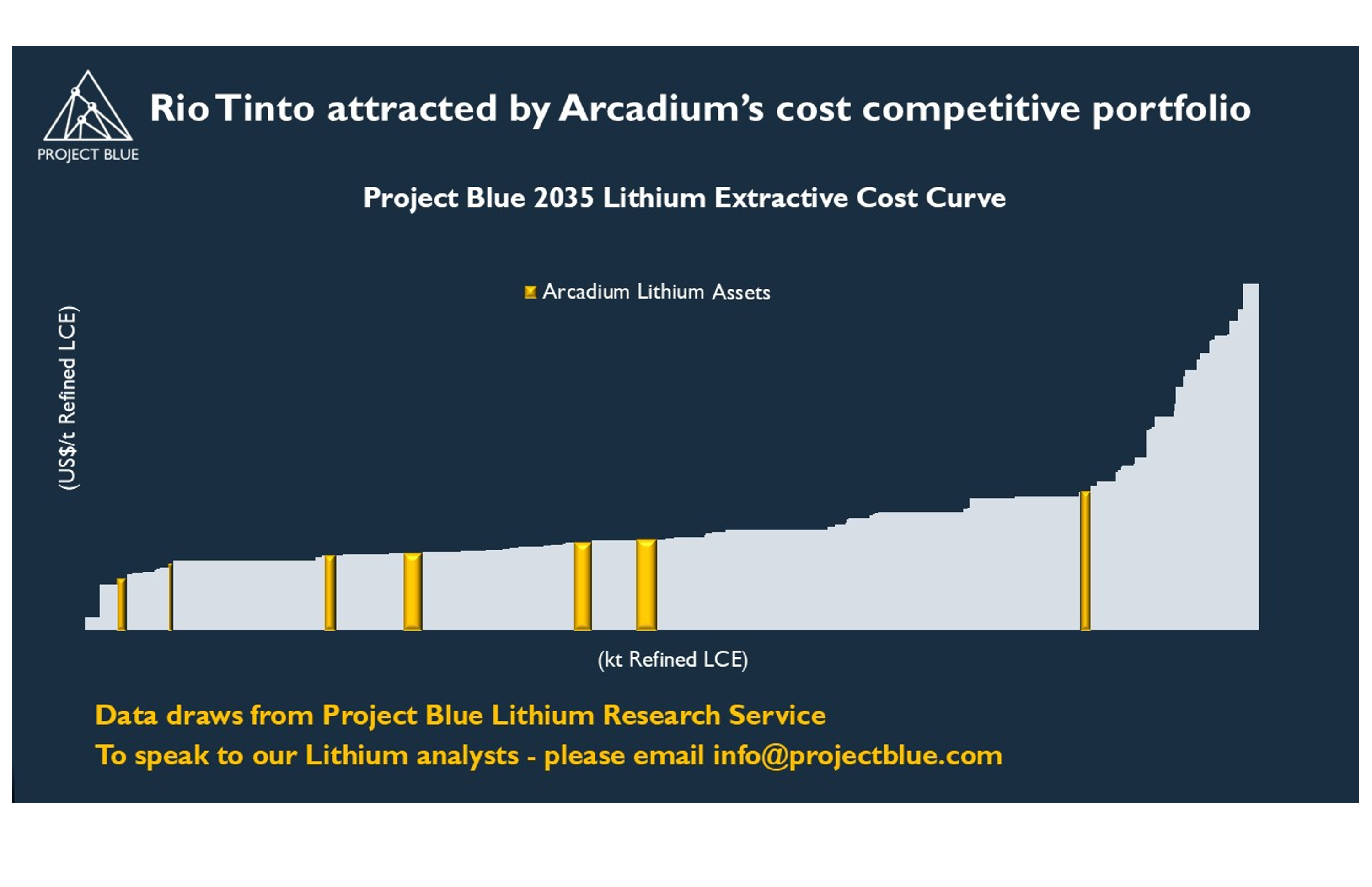Rio Tinto bets on brine with Arcadium acquisition
News Analysis

9
Oct
2024
Rio Tinto bets on brine with Arcadium acquisition
Rio Tinto confirms Arcadium Lithium has accepted an acquisition offer for US$6.7Bn, bringing Arcadium’s lithium brine, mineral, and chemicals assets into the Rio Tinto lithium portfolio.
Rio Tinto has confirmed that it will acquire Arcadium Lithium for US$5.85 per share, resulting in a cash transaction of US$6.7Bn, aiming for a deal completion in mid-2025. The initial approach had been reported by an unidentified Reuters source over the weekend to be in the region of US$4.0-6.0Bn.
A combined Arcadium-Rio Tinto asset portfolio shows a vote of confidence in lithium brine
Arcadium Lithium, being a consolidation of Livent and Allkem’s lithium assets after a merger of the two companies finalised in January 2024, holds lithium assets around the globe. Arcadium and Rio Tinto are both looking to develop lithium assets within Argentina, with Arcadium operating the Salar del Hombre Muerto and Salar de Olaroz operations along with associated processing facilities in Salta province, while Rio Tinto is developing the Rincon project. Both companies also have exposure to hard rock lithium operations, with Arcadium operating the Mt Cattlin mine in Australia, along with developing the James Bay and Nemaska projects in Canada, while Rio Tinto is looking to develop the Jadar project in Serbia.
A further synergy between Arcadium and Rio Tinto is the technical knowledge of direct lithium extraction (DLE) technologies. Arcadium operates a semi-DLE process at the Salar del Hombre Muerto, while Rio Tinto is undertaking significant test work on a DLE process for the Rincon operation. The combination of Arcadium and Rio Tinto’s commercial and technical knowledge on implementing DLE processes is expected to benefit the development of Rincon, but also the potential use of DLE processes at other lithium brine operations in South America.
Arcadium’s suite of lithium projects and operations occupy various positions on the industry cost curve. The company’s brine operations (Salar del Hombre Muerto and Salar de Olaroz) sit within the lower half of the cost curve in 2024. These are all located within Argentina, resulting in a high concentration of projects within a single jurisdiction. However, the Fraser Institute has recognised the attractiveness of Argentina as an investment location, even amongst the backdrop of economic turmoil within the nation over the last few years. This is due to an increasingly clear policy direction, along with a favourable tax code capping royalties at 3% and lithium export duties are currently capped at 4ARS per US dollar value. Argentina stands out within the lithium triangle as the only jurisdiction that allows fully private ownership.
However, Arcadium’s Mt Cattlin mineral asset in Western Australia is struggling to remain market competitive. Mt Cattlin is a high-cost producer with the Project Blue lithium extractive cost service showing the asset falling consistently within the 4th quartile of the cost curve, since operating costs started increasing in 2022. This performance, coupled with suppressed lithium prices, saw Arcadium announce the suspension of waste stripping activities at the mine in September this year, with a move to transition the asset to care and maintenance by mid-2025. However, Arcadium deem this asset ‘non-core’ to their main business. As a result, Rio Tinto may consider removing Mt Cattlin and other Arcadium mineral assets from their portfolio in favour of a focus on brine assets and developing DLE technology.
This move is seen as a vote of confidence for lithium brines. The proximity of Arcadium’s operations to Rincon’s existing DLE progress poses the acquisition as an opportunity to support the expansion of existing Arcadium solar evaporation operations through DLE. This may mitigate the need for large increases in the geographical footprint needed from solar evaporation capacity expansions. However, to develop DLE there is a considerable technical risk due to the high capital requirements, R&D budgets, and technical engineering issues that have beset a number of DLE-based lithium projects in the past.
The move to acquire Arcadium compared to their competitor Albemarle makes logical sense, with Albemarle having more exposure in Chile where the future of private companies in the region is potentially uncertain alongside exposure to high royalty payments. Albemarle also has a considerably larger market cap which would have made the acquisition more ambitious.
Where does Rio Tinto see value in Arcadium’s future lithium portfolio?
Over the next decade, Arcadium’s assets will occupy the full spectrum of the lithium industry cost curve. While Mt Cattlin is still expected be a high cost asset for the foreseeable future, Arcadium’s lithium brine projects show more promise. While their capital costs may be high, solar evaporation projects such as Sal de Vida and Cauchari show considerable potential given their low-projected operating costs from solar evaporation, even with cost contingencies added given their current project development stage.
This leads to favourable projected IRR’s for a number of Arcadium’s brine projects, considering Project Blue’s forecast lithium prices over the next two decades. Based on this, Rio Tinto appears to see value in Arcadium’s future brine projects, using a “plug in and play” acquisition to immediately bring the company into the realms of the largest lithium producers. Adding value is the fact that Rio Tinto’s existing DLE research and development has synergies with Arcadium’s existing assets. Looking further downstream, Arcadium also has considerable expertise and value in the lithium chemicals sector. This allows Rio Tinto modularity when it comes to pivoting between various lithium carbonate, hydroxide, chloride, metal and other niche refined lithium chemicals depending on how commodity premiums develop in the future as the lithium sector and downstream demand matures.